Can a freshwater tank with goldfish and guppies work? The short answer is yes, but not without some effort.
While there are a few parameters for these species that do not quite match up, such as water temperature, pH, and the adult size of the fish, there are areas of overlap that make a pairing possible.
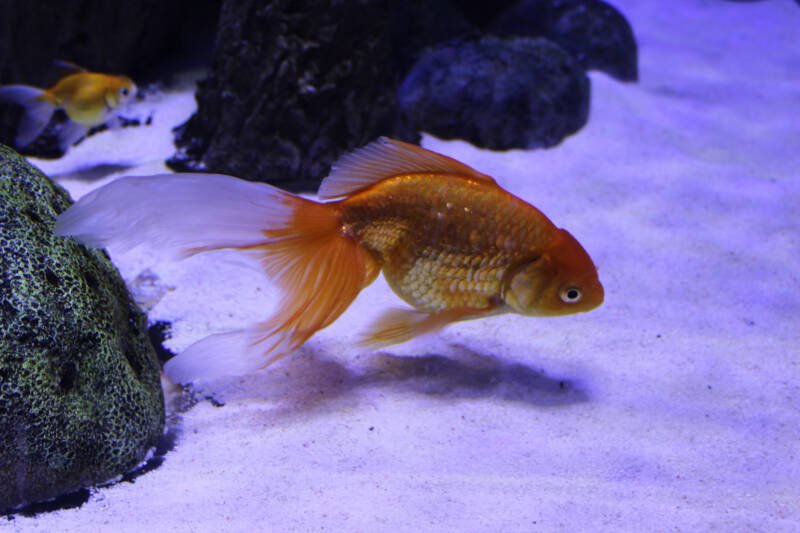
With a little bit of care taken in establishing a compatible tank environment and in selecting the right-sized fish, you can have an attractive and healthy guppy and goldfish aquarium.
We believe you will find that the result is well worth the effort. Goldfish and guppies are both beautiful fish that are lively and engaging.
A tank combining these two is not only visually stunning but also peaceful and calming to watch.
If you are considering keeping guppies with goldfish, read on for tips on how to make the perfect tank.
In this article
Fish Size
A guppy / goldfish tank is one where you must pay attention to the size of the fish you place together.
Many goldfish species grow quite large and pairing them with tiny guppies can be a tragic mistake.
Goldfish Sizes
It is the “fancy” type goldfish that are typically the smaller breeds, many reaching between five to six inches (12 to 15 cm) in length.
The larger goldfish species, such as the common, comets or Shubunkin goldfish, can grow as large as 12 to 14 inches (30 to 36 cm) as adults.
Either avoid these big goldfish or select young specimens.

The upside to selecting fancy goldfish is their smaller size. The downside is that many of these fish types are more difficult to care for.
Some variations, such as celestial eye goldfish and butterfly tail goldfish, have physical traits bred into them that impact their swimming ability and vision.

These fish should not be housed with fast-swimming fish or in tanks that have rough items that they can bump into and injure themselves.
Consider the hardier pearlscales, Ryukins, or fantail goldfish.
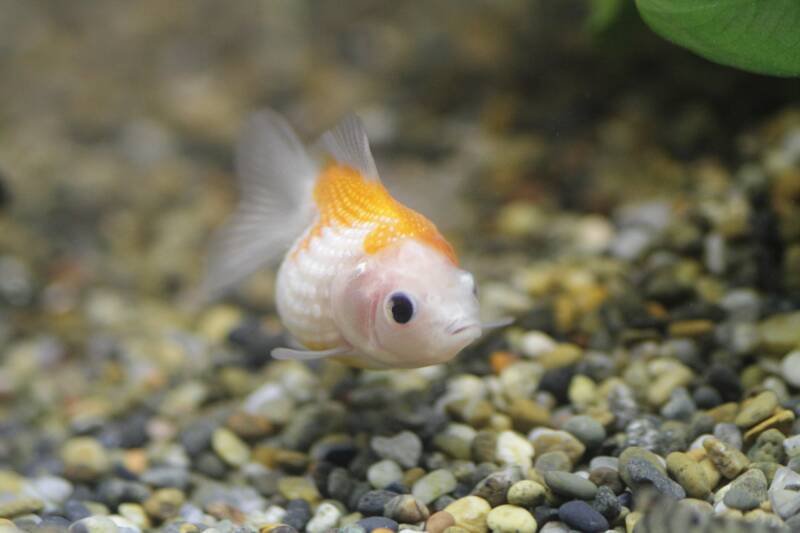
They reach between five to eight inches (13 to 20 cm) in length and come in a range of colors, including red, orange, white, black, and koi-like, calico coloration.
The slightly larger Ryukins and fantails can be a bit competitive in terms of feeding, so take care when keeping them with guppies.
Guppy Sizes
These fish are on the smaller end. Female guppies can reach between 1.2 to 2.4 inches (3 to 6 cm) in length, while male guppies stay smaller, reaching around 0.6 to 1.4 inches (1.5 to 3.6 cm).
Males are more colorful, with fancy fins and patterns.

Clearly, we are talking about a significant size difference between adult goldfish and guppies. That is where extra caution must be taken.
If you pair larger goldfish with younger guppies, your poor guppies are at risk of becoming a snack.
It is not due to aggression on behalf of the goldfish, per se, but more that goldfish cannot resist a ready food source that can fit into their mouths.
Your safest bet is to select younger, smaller species of goldfish and pair them with more mature guppies.
If you find that your goldfish is getting too large, then you may have to move them to another tank to ensure the safety of your guppies.
Temperament and Behavior
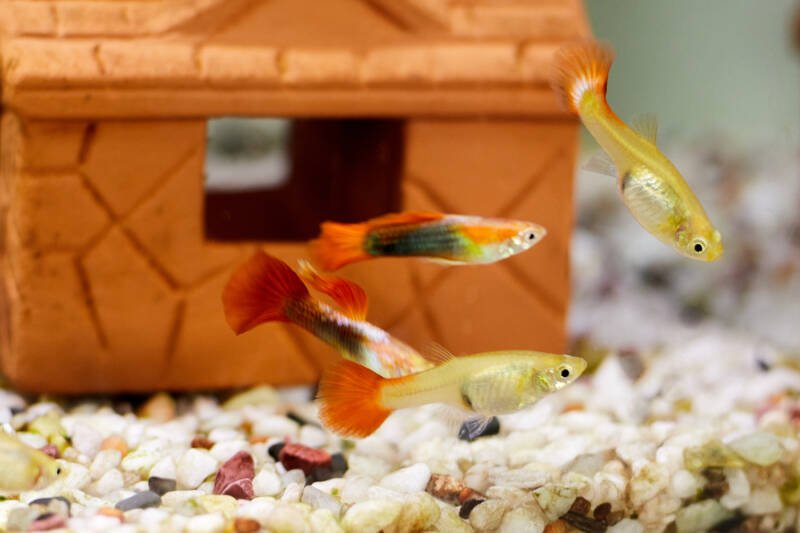
This aspect of pairing goldfish and guppies is easy as both are peaceful fish.
Guppies can squabble among themselves occasionally.
This aggression typically comes from males competing for the attention of females.
To keep the scuffles to a minimum, plan on a group of guppies in a male to female ratio of 1:2 or three.
Goldfish are gentle and quite social. They will not go out of their way to pick a fight with any other fish in the tank.

However, as mentioned above, goldfish are opportunistic omnivores that will pretty much eat anything. If you select compatible sizes of fish, there should not be any issues.
The nature of guppies and goldfish makes them great tank mates.
Guppies are active swimmers that love the middle to top levels of the water column.
Goldfish will visit all levels of the tank. Both species are highly social and enjoy the company of other fish.
Tank Setup
When setting up a tank for goldfish and guppies, consider the appropriate tank size, layout, and water conditions.
Tank Size

For a guppy tank, the minimum tank size is 10 gallons (40 l) for three guppies.
For each additional fish, add two gallons (10 l).
A goldfish tank should be a minimum of 20 gallons (80 l) for one goldfish, with 10 gallons (40 l) more for each additional fish.
Goldfish need a larger tank because not only do they love to swim, but they are also extraordinarily messy fish.
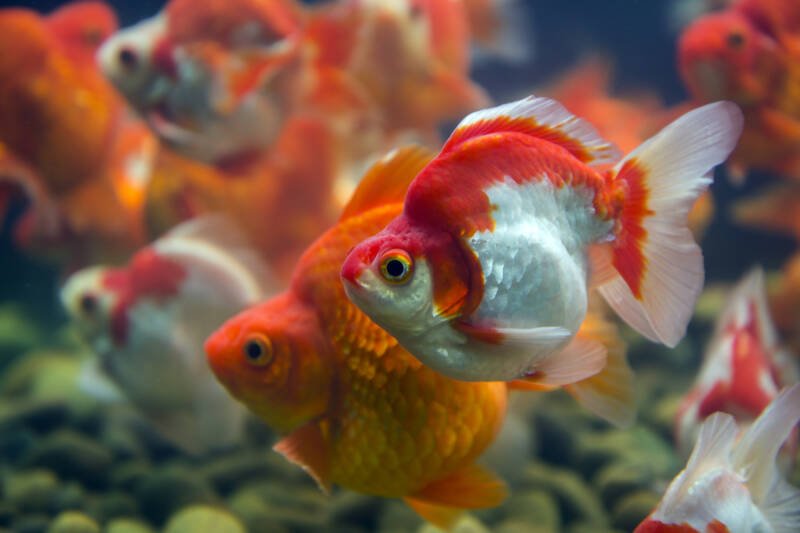
A larger tank will make maintaining water conditions easier, along with giving them the space they need to move around.
Install a quality filtration system to help keep the water clean.
For a combined guppy/goldfish tank, the minimum size you should consider is 20 gallons (80 l). This size will hold one goldfish and three guppies.
Again, for each additional goldfish, add 10 gallons (40 l) and add at least two gallons (10 l) for each additional guppy.
Layout and Décor
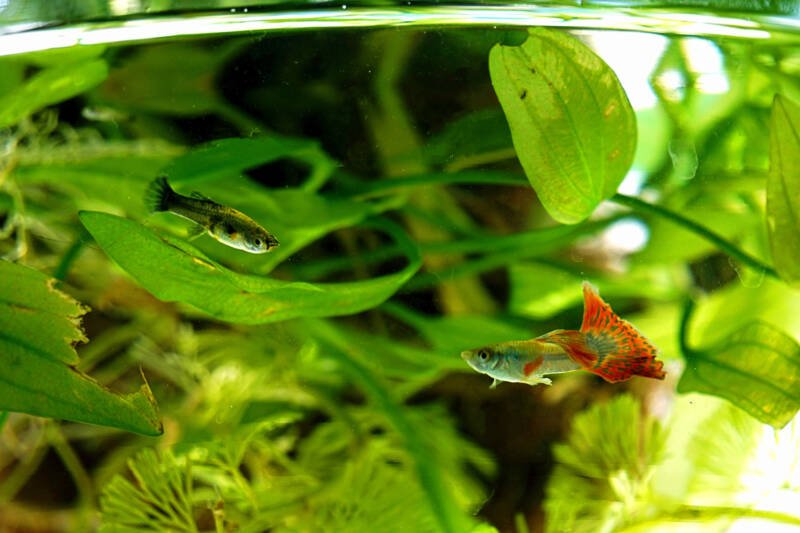
The smaller guppy comes from waters rich in vegetation with plenty of places to duck into when needed.
Replicate this in their tank using live plants, driftwood, rocks, or other decorative items.
You can choose any plant type, however, we recommend broad-leafed plants, such as anubias, to give your guppy a place to shelter.
When setting up the tank, be sure to leave a large swimming space for these active fish.
The goldfish’s native waters are likewise rich in plant life.
While they do not need dedicated hiding places, such as caves, they do need a place they can nestle into to rest when they feel the urge.
When selecting plants and decorations for your tank, include an option for your goldfish as well.
Water Conditions
This is one area where you must put in a little effort to maintain an environment in which both species will thrive.
Water Temperature
In general, goldfish prefer cold water, while guppies need warm temperatures.
Although goldfish can tolerate a wide temperature range (as low as 40°F/4°C for hardy, outdoor pond goldfish), they do best in the range of 68 to 74°F (20 to 23°C).
Guppies need their water slightly warmer, in the 72 to 82°F (22 to 27°C) range.
You can see that there is a small area of overlap between 72 and 74°F (22 to 23°C). Strive to maintain the water temperature within that range.
Installing a thermometer and heater can help to keep the temperature steady.
pH
The pH for a goldfish/guppy tank is best kept at a neutral 7.0.
Many goldfish species have an incredible range of pH tolerance.
The guppy’s range is from 6.8 to 7.8. A neutral pH will satisfy the needs of both fish.
Tank Maintenance
You will need to stay on top of water conditions for a guppy/goldfish tank to thrive.
As we said, goldfish are notoriously messy. Install a quality filter that can manage the tank size you have and rinse the filter medium monthly.
Test your water for ammonia, nitrite, and nitrate levels regularly and perform weekly water changes.
Nutrition

Guppies and goldfish are both omnivores that are easy to feed and accept a variety of foods.
Each fish thrives best on flake foods formulated for their species but needs a range of supplemented protein and plant foods to be healthy.
Fresh, live, frozen, or freeze-dried, the following are excellent choices for your fish:
- Daphnia
- Brine shrimp
- Mosquito larvae
- Blanched vegetables
- Algae wafers or nori.
In addition, adding items to the tank, such as driftwood or live rock, can encourage algae growth.
Both your guppies and goldfish will snack on this food source.
Breeding
If you are considering breeding your guppies, prepare a separate tank.
Goldfish will happily snack on guppy fry, so if you wish for them to develop to adulthood, a dedicated tank is necessary.
Closing Thoughts
A guppy/goldfish tank is a desirable combination due to the high activity level and peaceful nature of both species.
When housing these fish together, attention must be given to their habitat, water conditions, and the relative size of the fish.
If these needs are met, the result can be a spectacular freshwater tank!
Do you have a tank with guppies and goldfish?
What are your favorite species to pair?